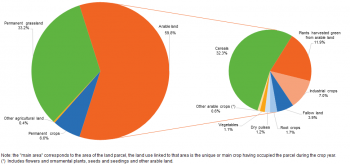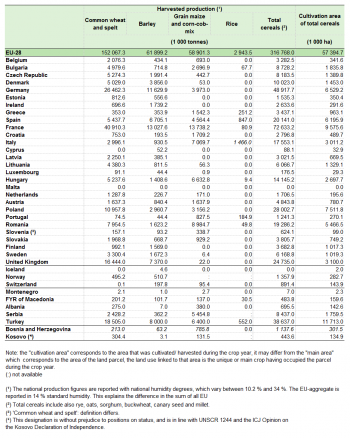Archive:Main annual crop statistics
This article has been archived, for updated data, see article Agricultural production - crops.
This article describes crop production in the European Union (EU) in 2015 and reports the main changes observed since 2010 for green maize and since 2007 for the other crops. Among the main agricultural crops, there were increases in the production of grain cereals and oilseeds between 2007 and 2015 in the EU and a decrease in the production of green maize between 2010 and 2015.
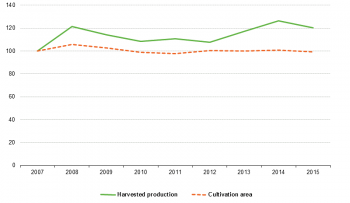
(2007=100)
Source: Eurostat (apro_acs_a)
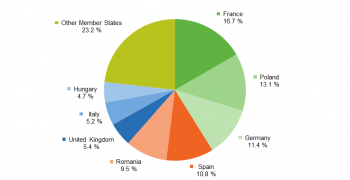
(% of total EU-28 area under cereals)
Source: Eurostat (apro_acs_a)
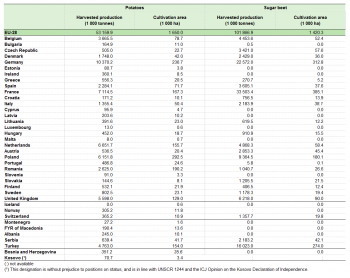
Source: Eurostat (apro_acs_a)
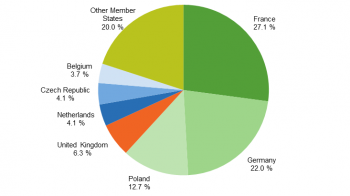
(% of total EU-28 area under sugar beet)
Source: Eurostat (apro_acs_a)
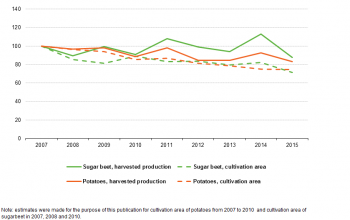
(2007=100)
Source: Eurostat (apro_acs_a)

Source: Eurostat (apro_acs_a)

Source: Eurostat (apro_acs_a)
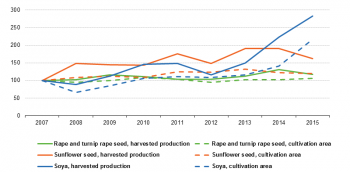
(2007=100)
Source: Eurostat (apro_acs_a)
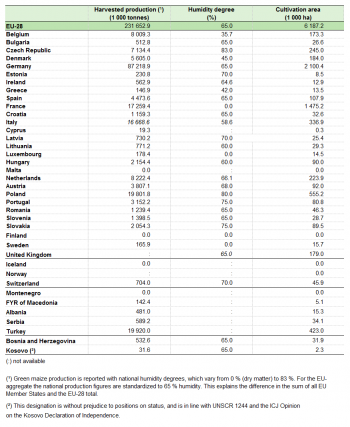
Source: Eurostat (apro_acs_a)

(2007=100)
Source: Eurostat (apro_acs_a)
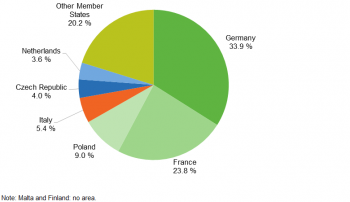
(% of total EU-28 area under green maize)
Source: Eurostat (apro_acs_a)
Main statistical findings
In the EU-28, in 2015, there was an increase in the harvested production of cereals (+ 6.3 %) and oilseeds (+ 9.6 %) compared to the previous 8-year average level. In contrast, the production of potatoes (– 10.3 %) and sugar beet (– 11.4 %) decreased during the same period. Moreover, the production of green maize decreased by 4.2 % compared to the 2010-2014 average.
France and Germany were by far the largest cereal, sugar beet and oilseed producers in 2015, and together they accounted for more than half (55.1 %) of the EU-28’s sugar beet production, 37.3 % of oilseed production, 45.1 % of green maize production and 38.4 % of cereal production. The production of potatoes was more widely spread across the EU Member States, with Germany recording the highest production volume (19.5 % of the EU-28 total), while the United Kingdom, Poland, the Netherlands and France each accounted for between 10 % and 14 %. France, the United Kingdom and Poland were the leading producers of dry pulses and responsible for close to half (49.9 %) of thetotal EU-28 production.
Cereals
Cereals dominate EU arable area
The EU-28 total Utilised Agricultural Area (UAA) covered nearly 179 million hectares in 2015. While the largest part (59.8 %) consisted of arable land, close to one third was occupied by permanent grassland, and 6.6 % by permanent crops (see Figure 1).
The main crops grown on the total of 107 million hectares of arable land available in the EU-28 in 2015 were cereals (including rice), which occupied around 57 million hectares. This equated to more than half of the total arable land or nearly one third of the total UAA (32.3 %). Cereals together with plants harvested green (11.9 % of the UAA), industrial crops (7.0 %) and fallow land (3.9 %) covered 92.3 % of the total arable land. The remaining area was dedicated to the growing of root crops (1.7 % of the UAA), dry pulses (1.2 %), vegetables (1.1 %), and other arable crops (0.6 %).
In the Nordic Member States, almost the entire utilised agricultural area was taken up by arable land: 98.6 % in Finland, 89.2 % in Denmark and 85.0 % in Sweden. Conversely, the proportion of arable land in total utilised agricultural area in 2015 was below 50 % in six Member States: Austria (49.5 %), Luxembourg (47.9 %), Slovenia (35.9 %), the United Kingdom (33.6 %), Portugal (30.2%) and Ireland (10.2 %). These countries also had the highest shares (close to 50 % of the total UAA or more) of permanent grassland, explained by pedologic and climatic factors and high numbers of grazing animals. The highest proportion of grassland was reported in Ireland (89.7 % of the total UAA). For permanent crops, only three Member States reported a share higher than 20% of the total UAA: Greece (24.9 %), Cyprus (20.8 %) and Portugal (20.3 %) followed closely by Spain (19.8 %) and Italy (19.3 %). These high proportions are linked to suitable climatic conditions for growing permanent crops such as olive trees, vineyards and fruit trees.
In 2015, France, Germany, Poland and the United Kingdom produced 55 % of EU’s cereals
Cereals, which occupied 57 million hectares, were the main crops grown in the EU-28 in 2015 (see Table 1). The harvested cereal production amounted to nearly 317 million tonnes, of which 152 million tonnes was common wheat and spelt. This made common wheat and spelt by far the most important cereals grown (48.0 % of EU-28 cereal production). The second largest harvested quantity was barley (62 million tonnes or 19.5 % of total cereal production), followed closely by grain maize and corn-cob-mix (59 million tonnes or 18.6 % of total cereal production). The production of other cereals (mostly triticale, rye and oats) had together a share of 12.9 % and only around 0.9 % of total EU production consisted of rice (around 3 million tonnes).
France (22.9 %), Germany (15.4 %) and Poland (8.8%) produced almost half of total EU-28 cereal production. Unsurprisingly, France and Germany were also the largest producers of wheat and barley. Together they accounted for nearly half (44.3 %) of total EU-28 wheat and spelt production and 39.8 % of total barley production. Other major producers of barley were Spain (10.8 %) and the United Kingdom (11.9 %). France was also the largest grain maize producer, accounting for 23.3 % of total grain maize production in the EU-28. Together with Romania (15.3 %), Italy (12.0 %) and Hungary (11.3 %), these four Member States covered 61.8 % of the total EU-28 grain maize production in 2015.
Only eight countries produced rice in the European Union due to challenging growing conditions and climatic prerequisites. Almost half (49.8 %) of total EU rice production in 2015 was reported by Italy, followed by Spain with 28.8 %.
4.8 % reduction of harvested production of cereals in 2015 after the 2014 peak
Cereal production has fluctuated considerably since 2007 (see Figure 2). Due to comparatively high cereal prices in 2007 caused by unbalanced supply and demand, EU farmers reacted with a significant production increase (+ 21.4 %, from 2007 to 2008). However, unfavourable weather conditions led to a production decrease in 2009 (– 5.9 % compared with 2008). The downward trend continued in 2010 and production decreased again by a further 5.2 % compared with 2009. Although in 2011 cereal production increased slightly (+ 2.4 % compared with 2010), a 2.8 % drop was registered in 2012. In the next two years the EU cereal production grew, by 8.7 % in 2013 and 7.9 % in 2014. In 2015 the harvested production was 316.8 million tonnes of cereals, a 4.8 % decrease compared with 2014. The 332.6 million tonnes of cereals in 2014 was the highest value recorded in the last 15 years for which data are available for all 28 Member States. Despite the production decreases of 2009, 2010, 2012 and 2015 the total level of cereal production in the EU-28 stood nevertheless 20.3 % higher in 2015 than in 2007 (an increase of 53.5 million tonnes).
In contrast to production, the harvested area of cereals in the EU-28 remained relatively stable between 2007 and 2015 – never fluctuating by more than 6 %. In 2015 the area was only slightly lower than in 2007 (– 1.0 %) and compared to the 2007–14 average area of cereals, it was 1.6 % less. In the Baltic Member States as well as in Belgium and Bulgaria there was a significant increase in the cultivation area compared to the 2007–14 average for cereals that ranged from 9.7 % in Belgium to 21.2 % in Latvia.
When comparing the 2015 values with the 2007–14 average, the discrepancy between the increase in harvested production (+ 6.3 %) and the area cultivated with cereals (– 1.6 %) suggests a significant improvement in yield.
The largest areas under cereals were registered in France (16.7 %), Poland (13.1 %) and Germany (11.4 %). Together, they accounted for 41.1% of total area under cereals in the EU (see Figure 3).
Root crops
Germany and France had the highest shares of potato and sugar beet production
In 2015, the largest area of root crops (1.7 million hectares) was occupied by potatoes, closely followed by sugar beet (1.4 million hectares). Other root crops not classified elsewhere (e.g. fodder beet, fodder kale, rutabaga, fodder carrot, turnips, etc.) were of lesser importance. Thus, this section concentrates on potatoes and sugar beet only and offers an overview of selected statistics and indicators linked to their production in the EU-28.
The EU was the world’s leading producer of sugar beet (48.5 % of world production in 2014)[1] with nearly 102 million tonnes harvested from about 1.4 million hectares in 2015. As shown in Figure 4, the largest areas were found in France and Germany, totalling around 0.7 million hectares (27.1 % and 22.0 % respectively of the EU-28 total). France (32.9 %) and Germany (22.2 %) together were responsible for more than half of EU-28 sugar beet production. The other important sugar beet producers in 2015 were Poland (9.2 % of total EU-28 production) and the United Kingdom (6.1 %). These four countries together accounted for 70.3 % of EU-28 production in 2015 (see Table 2).
In contrast to sugar beet, potato production was more widely spread across the EU Member States. Even so, Germany, which reported the highest level of production (19.5 % of the EU-28 total in 2015), and France (13.4 %) produced close to one-third of EU-28 total production. Together with three other Member States, the Netherlands (12.5 %), Poland (11.6 %) and the United Kingdom (10.5 %), these five countries produced 67.5 % of total EU-28 potato production. Poland had the largest harvested area in 2015 with nearly 0.3 million hectares (17.7 % of the EU-28 total potato area), followed by Germany and Romania, each harvesting around 0.2 million hectares. These three countries thus accounted for more than two fifths of the EU-28 total area of potato production.
Sugar beet — reduction in area and in production compared with 2007–14 average
Given the EU production quotas and increasing yields in the EU-28, the sugar beet area was reduced by 28.4 % between 2007 and 2015 (see Figure 5). Compared to the 2007–14 average the 2015 production area was 16.4 % smaller. In spite of this area reduction, production decreased by only 11.4 %. However there were large fluctuations in sugar beet production due to the Common Market Organisation (CMO) 2006 reform, followed by the restructuring of the sugar beet sector, which will lead to the end of quota management in September 2017.
The situation differed considerably in the individual Member States. In some Member States sugar beet production declined between and 2015 and the 2007–14 average: Portugal (– 89.7 %), Bulgaria (– 73.7 %), Greece (– 64.8 %), Sweden (– 48.1 %), Croatia (– 38.5 %) and Italy (– 37.3 %). In other Member States the sugar beet production volumes did not fall so much, and in some cases they even increased, eg in Romania (+ 20.3 %), Slovakia (+ 18.3 %) and Denmark (+ 6.2 %).
10.3 % decrease in production of potatoes in the EU compared with 2007–14 average
As in the case of sugar beet, both potato production and the area under cultivation declined between 2007 and 2015, although much more sharply for the area. Despite some fluctuations, the total harvested area dropped by 0.6 million hectares (– 25.4 %) between 2007 and 2015, this was – 14.5 % when compared with the 2007–14 average. In the same time span, production fell by 10.6 million tonnes (– 10.3 % reduction in relation to the 2007–14 average production). The situation differed considerably between countries, varying from significant increases in production in two Member States (Denmark + 14.6 % and Belgium + 7.1 %), to considerable reductions in Latvia (– 46.7 %), Malta (– 4.1 %), and Luxembourg (– 34.4 %). Still, these significant decreases have had only limited impact as these countries had little weight in total EU production (less than 0.5 % each in 2015). One single larger producer, Poland, with 2.9 million tonnes less than the 2007–14 average (– 31.8 %), has the largest impact on the overall production decline at EU-28 level.
Dry pulses
France is the largest EU producer of dry pulses
Dry pulses and protein crops for the production of grain are crops sown and harvested mainly for their protein content and include in particular field peas, broad and field beans, sweet lupins as well as other dry pulses such as dry beans, chick peas, lentils, vetches, etc. These crops are used mostly in animal feed.
Dry pulses were grown on 2.2 million hectares (2.1 % of total arable land) and their production reached 5.1 million tonnes in the EU-28 in 2015. The harvested production of field peas and broad field beans was 2.1 million and 1.9 million tonnes, respectively. Production and area of dry pulses differed considerably between the Member States.
France was the largest producer of dry pulses in 2015 (18.1 % of the EU-28 total) followed by the United Kingdom (17.9 %) and Poland (13.9 %). French production of field peas accounted for nearly a third (31.9 %) of total EU-28 production in 2015, followed by Germany (13.3 %) and Lithuania (11.0 %). The United Kingdom was the leading producer of broad and field beans in 2015, accounting for 38.0 % of the EU-28 total, followed by France (12.9 %) and Lithuania (9.9 %).
Spain and Poland accounted for more than two fifth of the total EU area of dry pulses in 2015 with over 0.5 million hectares.
Oilseeds
A fifth of the total EU oilseed production in France alone
Main oilseeds, rape and turnip rape, sunflower seed and soybeans, were grown on 11.6 million hectares across the EU Member States in 2015 (10.8 % of the total arable land), as shown in Table 4. Considered together, these main oilseed crops covered 97.4 % of the total EU oilseed area in 2015. Oilseeds are essentially used to provide vegetable oil, which is used in the food industry and in producing biodiesel. They are also used as an important protein-rich animal feed ingredient.
France was by far the largest main oilseed producer and accounted for more than one fifth of the EU total production and 19.4 % of the total EU harvested area of oilseed. Together with three other Member States (Germany with a share of 15.9 %, Romania with 9.3 % and Poland with a share of 8.5 %), more than half (55.1 %) of the total EU main oilseed production in 2015 was represented. Concerning rape and turnip rape, out of a total of 21,7 million tonnes harvested in 2015 (68 % of the total oilseed production), France was the largest producer with 24.5 % of the total production. Other important producers were Germany (23.1 % share), Poland (12.4 %) and the United Kingdom (11.7 %).
Sunflower seed production is concentrated in Eastern and Southern Europe. Romania was the largest producer, with 22.6 % of the sunflower production in 2015, followed closely by Bulgaria (with 21.5 %), Hungary (19.7 %) and France (15.0 %). Together these four Member States accounted for 78.8 % of the EU-28 sunflower seed production and covered nearly three quarters of the total EU-28 sunflower seed area in 2015. Large areas of sunflower production were also reported in Spain (over 0.7 million hectares or 17.6 % of the total EU sunflower seed area). Due to climatic conditions Spanish sunflower seed production amounted to only 9.7 % of the total EU-28 production.
Increase of 32 % in production of oilseed crops between 2007 and 2015
The production of vegetable oils in the EU has been encouraged due to the mandatory use of biofuels in the EU by 2020. As a result, the EU harvested production of main oilseed has grown considerably in recent years, namely 31.7 % from 2007 to 2015. The EU-28 main oilseed production was over almost 32 million tonnes in 2015, 9.6 % higher than the 2007–2014 average. As can be seen in Figure 6, the production of main oilseed crops increased from 2007 to 2015.The increase in production was always higher than the increase of the cultivation area.
The production of soya increased by 183.2 % from 2007 to 2015, and the 2015 harvest more than doubled if compared to the 2007–14 average (108.9 %). The biggest increases occurred especially in the last two years. Italy, France, Croatia and Hungary were among the countries with the largest increases both in harvested tonnes and in cultivated hectares of soya.
Despite the 14.8 % decrease from the 2014 to 2015, the harvested production of sunflower seed increased 62.2 % since 2007, and compared to the 2007–14 average the 2015 production of sunflower seed was 4.6 % higher, reaching 7.9 million tonnes in 2015. The corresponding cultivation area of sunflower seed also increased by 19.8 % from 2007 to 2015 and was 3.1 % higher than the 2007–14 average. Rape and turnip rape seed presented a more moderate growth during the same time span with an increase of 17.2 % (3.2 million tonnes) of the harvested production and a 5.4 % increase of the cultivation area. In 2015, the harvested production of rape and turnip rape seed was above the 2007–14 averages (4.5 % in the case of the area and 6.4 % in the case of the quantity of harvested production).
Green maize
In 2015, Germany was the EU-28’s leading producer of green maize
Plants harvested green are arable crops intended for animal feed, or for renewable energy. They are grown in rotation with other plants and include green maize, other cereals, leguminous plants and temporary grasses.
This section concentrates on green maize only and aims to give an overview of the selected statistics and indicators linked to its production in the EU-28.
Green maize was harvested from almost 6.2 million hectares in the EU-28 in 2015 (see Table 5). The area increased by 0.7 million hectares (+13.4 %) if compared with 2010 area and by 6.1 % if compared to the average of the values registered between 2010 and 2014. The production amounted to 232 million tonnes, nearly 32 million tonnes more than in 2010 (+16 %), but it corresponded to a 4.2 % decrease compared with the 2010–14 average (see Figure 7). Natural conditions and both production and consumption behaviour resulted in varied production patterns across the individual Member States.
Germany was the EU-28’s leading producer of green maize with more than one third of total production (slightly over 87 million tonnes harvested from about 2.1 million hectares in 2015). Germany and four other Member States (France, Poland, Italy and the Czech Republic), together accounted for over three quarters of total EU-28 green maize area (see Figure 8).
Between 2010 and 2015, significant increases in production of green maize were observed in Estonia (+ 105.2 % above the 2010–14 average) and Latvia (+ 54.1 % above the 2010–14 average).
Data sources and availability
Statistics on crop products are obtained from sample surveys, administrative data and estimates based on expert observations. The sources vary from one EU Member State to another because of national conditions and statistical practices. National statistical institutes or Ministries of Agriculture are responsible for data collection in accordance with EU Regulations. The finalised data sent to Eurostat are as harmonised as possible. Eurostat is responsible for establishing EU aggregates.
The statistics collected on agricultural products cover more than 100 individual crop products. Information is collected for the area under cultivation (expressed in 1 000 hectares), the quantity harvested (expressed in 1 000 tonnes) and the yield (expressed in 100 kg per hectare). For some products, data at national level may be supplemented by regional statistics at NUTS level 1 or level 2.
Context
This article gives an overview of European crop production, based on data provided to Eurostat by the EU-28 Member States under Regulation (EC) No 543/2009 and Regulation (EU) No 1557/2015 concerning crop statistics.
The term ‘crop’ covers a very broad range of cultivated plants. Within each type of crop there can also be considerable diversity in terms of genetic and phenotypic (physical or biochemical) characteristics. The range and variety of crops grown across the European Union (EU) reflects their heritable traits as well as the ability of plant breeders to harness those traits to best respond to the myriad of topographic and climatic conditions, pests and diseases.
The statistics on crop production in this article are shown at an aggregated level and have been selected from over 100 different crop products for which official statistics are collected.
See also
- Agricultural production - crops
- Dry pulses in EU agriculture - statistics on cultivation, production and economic value
- The EU potato sector - statistics on production, prices and trade
- The fruit and vegetable sector in the EU - a statistical overview
- Vineyards in the EU - statistics
- Farm structure survey 2013 - main results
Further Eurostat information
Publications
- Over 3 million hectares of vineyards in the EU - News release n°57/2017
- Agriculture, forestry and fishery statistics - 2016 edition
- Apples and tomatoes were the top fruit and vegetable produced in the EU in 2015 - News release n°126/2016
- Agriculture, forestry and fishery statistics — 2015 edition
Main tables
- Agriculture, see:
- Agricultural production (t_apro)
- Crop products (t_apro_cp)
- Utilised agricultural area by categories (tag00025)
- Cereals for the production of grain (including seed) by area, production and humidity (tag00027)
- Wheat and spelt by area, production and humidity (tag00047)
- Rye and winter cereal mixtures by area, production and humidity (tag00049)
- Barley by area, production and humidity (tag00051)
- Oats and spring cereal mixtures by area, production and humidity (tag00053)
- Grain maize and corn-cob-mix by area, production and humidity (tag00093)
- Dry pulses and protein crops for the production of grain (including seed and mixtures of cereals and pulses) by area, production and humidity (tag00094)
- Rape, turnip rape, sunflower seeds and soya by area (tag00100)
- Green maize by area, production and humidity (tag00101)
- Root crops and plants harvested green from arable land by area (tag00103)
- Fresh vegetables and strawberries by area (tag00115)
- Crop products (t_apro_cp)
Database
- Agriculture, see:
- Agricultural production (apro_cp)
- Crop statistics (area, production and yeild) (apro_acs)
- Crop statistics (from 2000 onwards) (apro_acs_a)
- Crop statistics (area, production and yeild) (apro_acs)
Dedicated section
Source data for tables, figures and maps (MS Excel)
Methodology / Metadata
- Crop statistics (area, production and yield) (apro_acs) - ESMS metadata file
Other information
- Commission Delegated Regulation (EU) No 1557/2015 of 13 July 2015 amending Regulation (EC) No 543/2009 of the European Parliament and of the Council concerning crop statistics (Text with EEA relevance)
- Regulation (EC) No 543/2009 of 29 June 2009 concerning crop statistics and repealing Council Regulations (EEC) 837/90 and (EEC) 959/93
- ESS Agreement on annual crop statistics: additional crop variables and early estimates
Notes
- ↑ FAOSTAT data are updated to 2014
